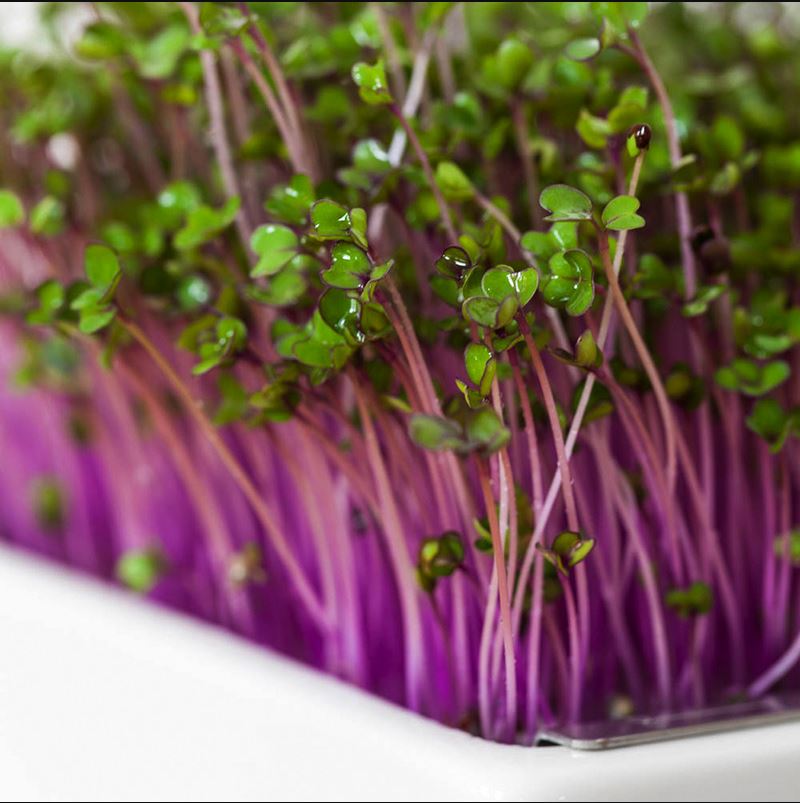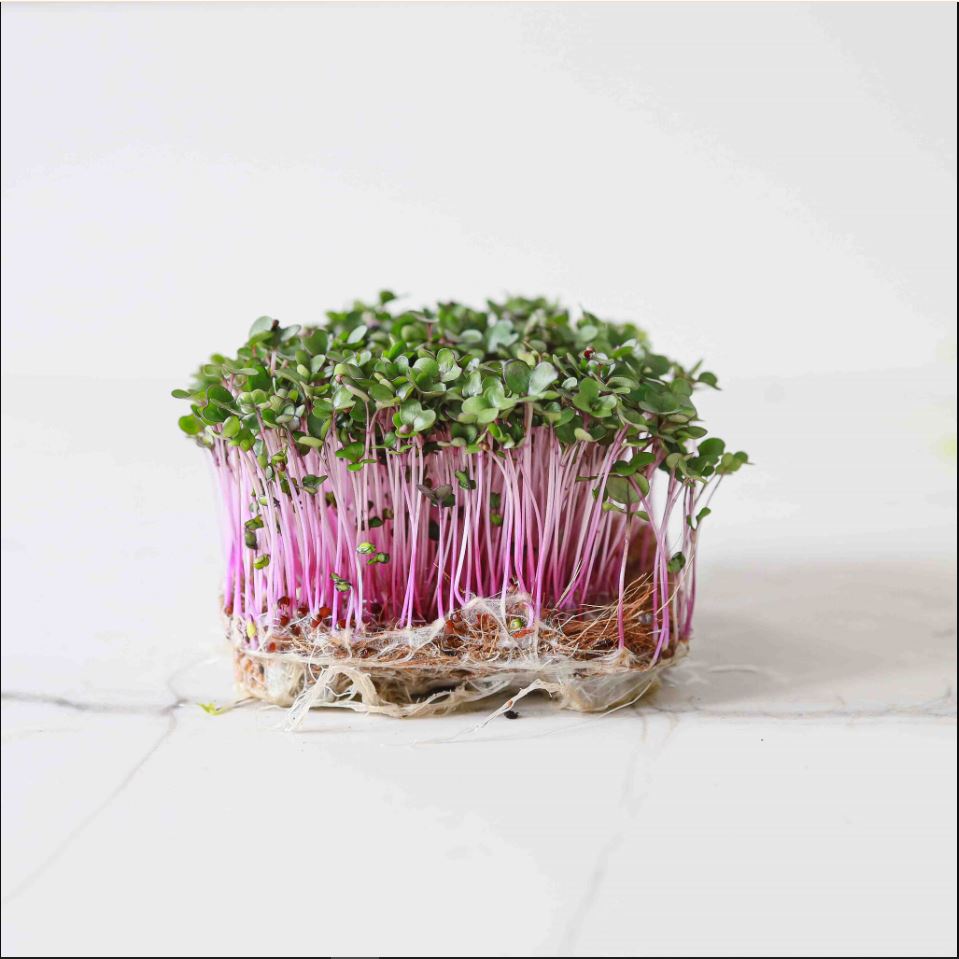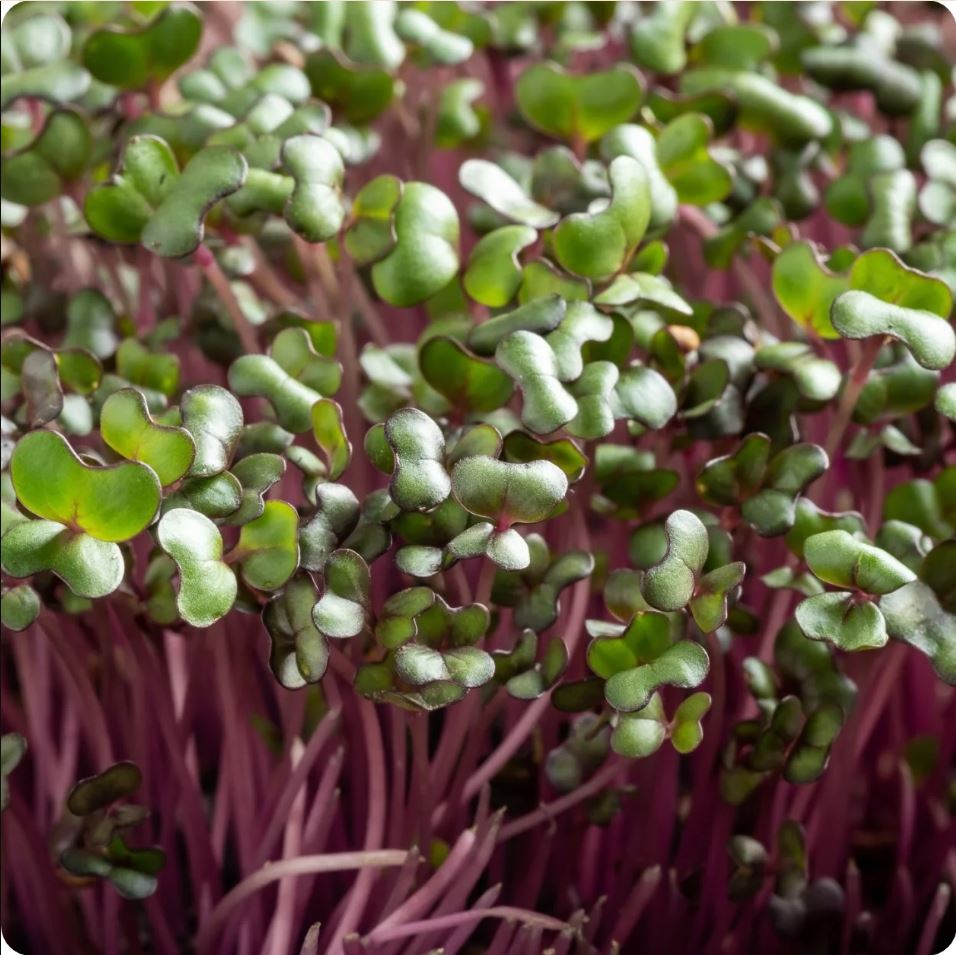Red Cabbage Microgreens A Surprising Way to Get More Vitamin
Red cabbage microgreens, with their vibrant green leaves and striking violet stems, are not just a visual treat but a powerhouse of nutrition. As part of the broader category of microgreens, these tiny but mighty greens have gained immense popularity among health enthusiasts for their dense nutritional profile and versatility in cooking. Microgreens, in general, are young vegetable greens harvested just after the cotyledons (the first leaves of a seedling) have developed. They are appreciated not only for their flavor but also for their nutritional content, which can exceed that of their mature plant counterparts.
Particularly, red cabbage microgreens stand out due to their high levels of vitamin K, a crucial nutrient involved in blood coagulation and bone health. These microgreens provide a much higher concentration of vitamins and minerals compared to mature red cabbage. In fact, studies have shown that they contain up to 40 times the amount of vitamin E and six times the amount of vitamin C as their adult versions. Additionally, these microgreens are rich in carotenoids, antioxidants that play a key role in preventing diseases and improving eye health.
The aesthetic appeal of red cabbage microgreens also makes them a popular choice for garnishing and adding a splash of color to dishes. Beyond their beauty, the mild yet distinct cabbage flavor enhances salads, sandwiches, and even warm dishes like omelets and baked potatoes. Given their nutritional benefits and culinary versatility, red cabbage microgreens offer a unique opportunity for anyone looking to enrich their diet with healthy and flavorful options. Whether used as a garnish or a main ingredient, they bring both color and a nutritional boost to every meal.
| Aspect | Details |
|---|---|
| Description | Red cabbage microgreens are young vegetable greens with vibrant green leaves and violet stems, harvested just after the cotyledons have developed. |
| Nutritional Profile | High in vitamin K, vitamin E, and vitamin C; contains up to 40 times the vitamin E and six times the vitamin C of mature red cabbage. Rich in carotenoids and antioxidants. |
| Culinary Uses | Popular for garnishing, enhancing the flavor of salads, sandwiches, omelets, and baked potatoes. Adds color and nutritional value to dishes. |
| Health Benefits | Supports blood coagulation, bone health, disease prevention, and eye health due to high levels of vitamins and antioxidants. |
Contents
Nutritional Benefits of Red Cabbage Microgreens
Red cabbage microgreens are not only striking in appearance but also exceptional in their nutritional offerings. These tiny greens pack a potent punch of vitamins and minerals. They are particularly renowned for their high vitamin content. For instance, red cabbage microgreens boast significant levels of vitamin K, which is essential for blood clotting and bone health. Research has shown that these microgreens can offer more vitamin K per gram than many other popular leafy greens, including mature red cabbage and even spinach.
Comparatively, while spinach is often celebrated as a superfood for its nutrient richness, red cabbage microgreens surpass it in vitamin K content. This is noteworthy because vitamin K not only helps with blood coagulation but also plays a crucial role in maintaining bone density and preventing osteoporosis. This makes red cabbage microgreens an excellent dietary addition for those concerned with bone health and blood function.

Beyond vitamin K, these microgreens are a treasure trove of other nutrients. They contain exceptionally high levels of carotenoids—antioxidants that are vital for preventing disease and protecting the body against oxidative stress. Carotenoids such as beta-carotene convert to vitamin A in the body, which is crucial for skin health and vision. Red cabbage microgreens have 260 times more carotenoids than mature red cabbage, making them a superior choice for anyone looking to boost their antioxidant intake.
Additionally, these microgreens are abundant in vitamin E and vitamin C—both known for their antioxidant properties. Vitamin E protects the body from oxidative damage and supports immune function, while vitamin C is integral to collagen production, immune defense, and even acts as an antioxidant. Remarkably, red cabbage microgreens contain 40 times the amount of vitamin E and six times the amount of vitamin C compared to their mature counterparts.
Lutein, another significant nutrient found in red cabbage microgreens, is specifically known for its role in eye health. It helps prevent macular degeneration and cataracts, which are common as we age. Given that red cabbage microgreens have higher levels of lutein than spinach, they are an excellent choice for those looking to protect and improve their vision.
| Nutrient | Details | Comparison |
|---|---|---|
| Vitamin K | Essential for blood clotting and bone health. | Higher content per gram than many other leafy greens, including mature red cabbage and spinach. |
| Carotenoids | Antioxidants crucial for disease prevention and oxidative stress protection. Converts to vitamin A in the body. | 260 times more than mature red cabbage. |
| Vitamin E | Protects the body from oxidative damage and supports immune function. | 40 times more than mature red cabbage. |
| Vitamin C | Integral to collagen production, immune defense, and acts as an antioxidant. | Six times more than mature red cabbage. |
| Lutein | Known for its role in eye health, preventing macular degeneration and cataracts. | Higher levels than in spinach, making it superior for eye health. |
How to Grow Red Cabbage Microgreens
Growing red cabbage microgreens at home is a simple and rewarding process that requires minimal equipment and space. These microgreens can thrive on a windowsill or any small area with sufficient light.
Step-by-step guide to growing red cabbage microgreens
- Preparation of Seeds and Growing Medium: Start by selecting a high-quality seed mix labeled specifically for microgreens. Use a shallow tray and fill it with a sterile, nutrient-rich growing medium like coconut coir or a soilless mix designed for seedlings.
- Blackout Period: After sowing the seeds evenly across the surface of the medium, lightly cover them with a thin layer of soil. Then, place another tray or a dark dome over the seeds to block out light. This blackout period, lasting about 3-4 days, is crucial as it helps to stimulate root growth before the seedlings seek light.
- Daily Maintenance: During the blackout period, ensure the medium stays moist by misting it with water daily. Keep the setup at a consistent room temperature—ideally around 20°C (68°F).
- Light Exposure: Once the seeds have sprouted and the initial leaves are visible, remove the cover to expose them to light. This exposure is vital for photosynthesis, which encourages the development of the characteristic vibrant green and purple hues in the leaves. Continue to mist the plants to keep the medium moist.
By following these steps, red cabbage microgreens can be ready to harvest in just 8 to 12 days, providing a quick turnaround from seed to plate. The ease of growing these nutritious microgreens makes them an ideal addition to any kitchen garden.
| Step | Process | Details |
|---|---|---|
| Preparation | Seeds and Growing Medium | Select a high-quality seed mix for microgreens. Fill a shallow tray with a sterile, nutrient-rich growing medium like coconut coir or a soilless mix. |
| Blackout Period | Covering and Darkness | After sowing seeds evenly, cover them with a thin layer of soil. Place another tray or dark dome over to block light for 3-4 days to stimulate root growth. |
| Daily Maintenance | Misting and Temperature | During the blackout, mist daily to keep the medium moist. Maintain a consistent room temperature around 20°C (68°F). |
| Light Exposure | Introduction to Light | Once seedlings sprout and cotyledons are visible, remove the cover to expose them to light. Continue misting to keep moist. |
| Harvest | Ready to Eat | Red cabbage microgreens are ready to harvest in 8 to 12 days, from seed to plate. Enjoy your freshly grown microgreens! |
Harvesting Your Cabbage Microgreens
Harvesting red cabbage microgreens at the right time is crucial for maximizing their flavor and nutritional benefits. The ideal time frame for harvesting these microgreens is when they are about 2 inches tall, which typically occurs around 8-12 days after planting. At this stage, the seed leaves (cotyledons) are fully developed, and the first set of true leaves may have begun to emerge.
Instructions on How to Correctly Harvest
Select the Right Tool: Use a sharp pair of scissors or a small knife to cut the microgreens. This method ensures a clean cut that does not damage the plant or the roots.
Cutting Technique: Harvest the microgreens by cutting just above the soil line. This technique ensures that you collect as much of the leafy green as possible, while leaving the root behind.

Immediate Washing: After cutting, gently rinse the microgreens under cool water to remove any soil or debris. This not only cleans them but also slightly rehydrates the leaves, enhancing their crispness.
Drying: Pat the microgreens dry with a clean towel or use a salad spinner to remove excess water. This step is essential to prevent spoilage and extend freshness.
Tips on Storing Microgreens
Immediate Refrigeration: Place the freshly harvested microgreens in a container lined with a paper towel. The paper towel will absorb any excess moisture, which helps prevent wilting and spoilage.
Loose Covering: Cover the container loosely to allow for air circulation while preventing the greens from drying out.
Regular Checks: Check on your microgreens daily for any signs of spoilage or excess moisture and replace the paper towel as needed.
Consumption Time: Ideally, consume the microgreens within a week of harvesting for the best flavor and nutritional value.
| Phase | Process | Details |
|---|---|---|
| Harvest Timing | Optimal Growth Stage | Harvest when microgreens are about 2 inches tall, typically 8-12 days after planting, when cotyledons are fully developed and true leaves are emerging. |
| Harvesting Tools | Selection of Tools | Use a sharp pair of scissors or a small knife to ensure a clean cut, which helps prevent damage to the plant and roots. |
| Cutting Technique | Method of Cutting | Cut the microgreens just above the soil line to maximize the harvest of leafy greens while leaving the root behind. |
| Washing | Cleaning Process | Gently rinse under cool water immediately after harvesting to remove soil or debris and rehydrate the leaves. |
| Drying | Removing Excess Water | Pat dry with a clean towel or use a salad spinner. This is crucial to prevent spoilage and maintain freshness. |
| Storage Preparation | Initial Steps | Place in a container lined with a paper towel to absorb excess moisture, helping prevent wilting and spoilage. |
| Storage Cover | Container Covering | Cover the container loosely to allow air circulation and prevent the greens from drying out. |
| Regular Maintenance | Monitoring and Adjusting | Check daily for spoilage or excess moisture; replace the paper towel as needed to maintain optimal conditions. |
| Consumption | Optimal Use | Consume the microgreens within a week of harvesting for the best flavor and nutritional value. |
Enjoying Your Fresh Cabbage Microgreens
Red cabbage microgreens are not only nutritious but also highly versatile in the kitchen. Their vibrant color and mild cabbage flavor make them an excellent addition to a variety of dishes.
Incorporating Microgreens into Dishes
Salads: Toss red cabbage microgreens into your salads for added color, texture, and nutrients. They pair well with a variety of dressings and other salad greens.
Sandwiches and Wraps: Add a crunchy, nutritious kick to your sandwiches and wraps with a handful of microgreens.
Smoothies: Incorporate a small amount of microgreens into smoothies for a nutrient boost that doesn’t overpower the other flavors.
Importance of Combining with Fats
Vitamin K, abundant in red cabbage microgreens, is fat-soluble, meaning it is better absorbed when consumed with fats. To enhance the absorption of vitamin K:
Healthy Fats: Include ingredients like avocados, nuts, seeds, or olive oil in dishes that use red cabbage microgreens.
Cooking Tips: When cooking, lightly sauté microgreens in a small amount of healthy oil to help unlock vitamin K for your body to absorb.

Creative Meal Ideas
Avocado Toast: Sprinkle a generous amount of red cabbage microgreens on top of avocado toast for a delicious and nutritious breakfast or snack.
Omelets: Add microgreens to omelets along with other vegetables like tomatoes and onions for a flavorful and colorful meal.
Baked Potatoes: Top baked potatoes with a mix of sour cream and red cabbage microgreens for a tasty and eye-catching side dish.
By incorporating red cabbage microgreens into your diet, you not only enhance the visual appeal of your meals but also boost their nutritional content significantly. Their versatility and health benefits make them a valuable addition to any meal, from simple snacks to elaborate dishes.
| Usage | Details | Benefits |
|---|---|---|
| Salads | Add red cabbage microgreens to salads for extra color, texture, and nutrients. They blend well with various dressings and salad ingredients. | Enhances visual appeal and nutritional value of salads. |
| Sandwiches and Wraps | Include a handful of microgreens in sandwiches and wraps for a crunchy, nutritious addition. | Adds a fresh, vibrant touch and boosts nutrient content. |
| Smoothies | Incorporate a small portion of microgreens into smoothies for a subtle nutrient boost. | Enhances nutrient density without overpowering other flavors. |
| Combining with Fats | For better absorption of fat-soluble vitamin K, combine microgreens with healthy fats like avocados, nuts, seeds, or olive oil. | Improves the bioavailability of vitamin K, crucial for blood clotting and bone health. |
| Avocado Toast | Sprinkle microgreens on avocado toast for a nutritious enhancement. | Offers a delicious and healthful twist to a popular dish. |
| Omelets | Add microgreens to omelets with vegetables like tomatoes and onions for extra flavor and color. | Makes breakfast more colorful and nutritious. |
| Baked Potatoes | Top baked potatoes with sour cream and red cabbage microgreens for an appealing side dish. | Provides a visually appealing and tasty addition to a classic meal. |
Red cabbage microgreens are a vibrant, nutritious, and versatile addition to any diet, combining profound health benefits with culinary flexibility. These small greens are not only aesthetically pleasing with their rich violet stems and lush green leaves but are also nutritional powerhouses. Packed with essential vitamins and minerals, they offer significant health advantages that can contribute to a balanced and healthful diet.
The dense nutritional profile of red cabbage microgreens includes high levels of vitamin K, which is critical for blood clotting and bone health. Additionally, these microgreens contain antioxidants such as carotenoids, vitamin E, and vitamin C at levels much higher than those found in mature vegetables. Carotenoids play a crucial role in disease prevention and the maintenance of good health, while vitamin E supports immune function and skin health. Vitamin C is pivotal for immune defense, collagen production, and acts as an antioxidant, protecting the body against free radical damage. Furthermore, the presence of lutein in red cabbage microgreens surpasses that in many other greens, promoting eye health and potentially preventing age-related ocular diseases.
Red cabbage microgreens are not only beneficial for their health properties but also for their versatility in the kitchen. Their mild, pleasant flavor allows them to blend seamlessly into a variety of dishes. From enhancing the nutritional value of salads and sandwiches to adding color and crunch to smoothies and omelets, these microgreens can elevate ordinary meals into nutrient-rich feasts. They are particularly effective when used as garnishes, providing a pop of color and a boost of nutrients simultaneously.
Growing red cabbage microgreens is an accessible venture for anyone, regardless of gardening experience. The simple cultivation process, which involves sowing seeds in a suitable medium, overseeing a brief blackout period for germination, and ensuring adequate light and moisture, makes it possible for these greens to be harvested within just 8-12 days. This quick turnaround from seed to table not only fosters a connection to the food you eat but also ensures a fresh, nutrient-rich addition to your diet.
The act of integrating red cabbage microgreens into daily meals can significantly enhance your nutritional intake. These microgreens make it easy to enrich your diet with essential nutrients without needing to overhaul your eating habits. The ease of incorporating them into dishes you already enjoy means that improving your diet can be both delicious and straightforward.
In an age where health consciousness is paramount, red cabbage microgreens offer a practical, efficient, and tasty way to boost dietary health. Their rich nutritional content supports various aspects of physical health, from enhancing bone density to boosting immune system performance and protecting vision. Additionally, their culinary flexibility makes them a delightful addition to a wide array of dishes, enhancing the eating experience with their texture and flavor.
As we conclude, consider the simple joy and profound benefits of growing and incorporating red cabbage microgreens into your diet. This small change can have a significant impact on your health, wellness, and enjoyment of food. Whether you’re a seasoned chef or a home cook, red cabbage microgreens provide an easy and effective way to elevate your meals and your health. Start a tray of red cabbage microgreens today, and step into a world of vibrant flavors and enhanced nutrition.
Cabbage -Spice Up Your Holiday Table Red Cabbage and Bacon Recipe
Savory and Sweet Braised Red Cabbage and Apples Recipe
Easy Pickled Red Cabbage Recipe
Ground Turkey Cabbage Skillet for a Healthy Weeknight Meal
The Ultimate Guide to Making the Most of Frozen Cabbage
Ethiopian Cabbage and Potato Dish A Simple Flavorful Recipe
How to Grow and Care for Late Flat Dutch Cabbage
